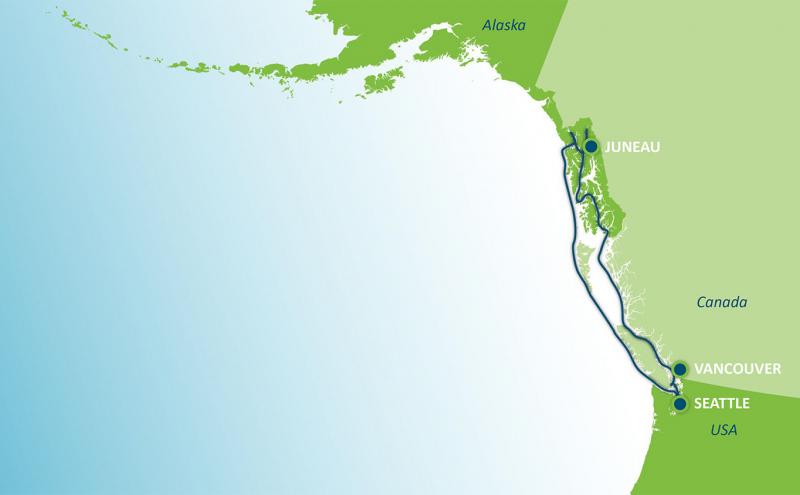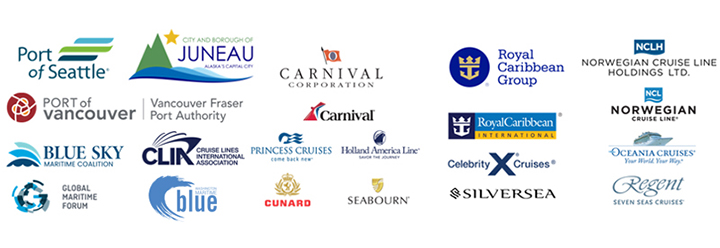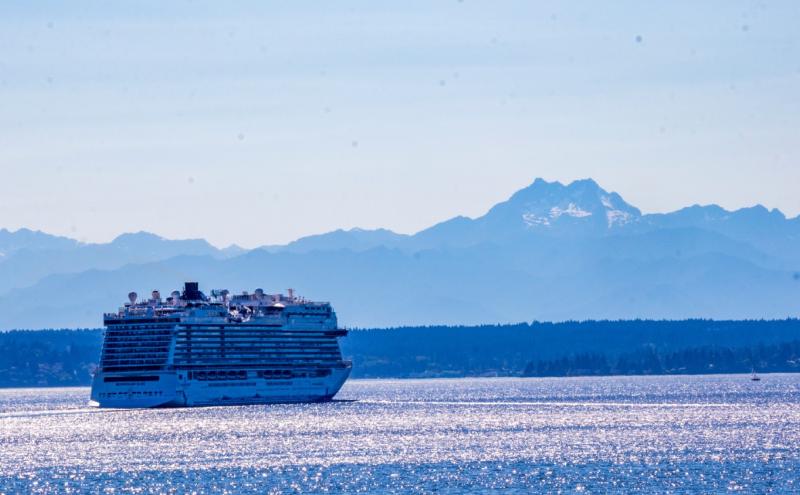

The Port of Seattle, City and Borough of Juneau, Vancouver Fraser Port Authority, leading global cruise lines, as well as the Global Maritime Forum, Blue Sky Maritime Coalition, and Washington Maritime Blue announced a new commitment today to explore the feasibility of the world’s first cruise-led ‘green corridor.’
Cruise line and industry partners include Carnival Corporation and its cruise brands including Princess Cruises, Holland America Line, Carnival Cruise Line, Seabourn, and Cunard; Norwegian Cruise Line Holdings and its cruise brands including Norwegian Cruise Line, Oceania Cruises, and Regent Seven Seas Cruises; Royal Caribbean Group including its brands Royal Caribbean International, Celebrity Cruises, and Silversea Cruises; and Cruise Lines International Association, the world’s largest cruise industry trade association.
The First Mover Commitment was announced during the International Association of Ports and Harbors World Ports Conference in Vancouver, British Columbia.
- First Movers took questions from the media on Tuesday, May 17. Watch the media availability.
A green corridor is a maritime route where zero greenhouse gas emission solutions are demonstrated and supported. Green corridors — through collaboration across sectors — create the technological, economic, and regulatory feasibility needed for zero greenhouse gas emission ships to succeed.
The collaborative effort is aimed at exploring the feasibility of a green corridor that could accelerate the deployment of zero greenhouse gas emission ships and operations between Alaska, British Columbia, and Washington. Nearly 300 ships leave Seattle for Alaska in a six-month cruise season; in total Alaska hosts more than 600 cruise sailings per year.
First Mover partners will leverage and support each other’s decarbonization work already underway and bring those resources and technological advancements to this focused and coordinated effort. Partners agree to:
- Work together to explore the feasibility of a green corridor in the Pacific Northwest of North America, including, but not limited to, further defining the scope and application of the green corridor concept;
- Enhance and support the emission-reduction efforts already underway and use the green corridor as a testbed for low and zero greenhouse gas technologies and ships, as feasible; and
- Work collaboratively to define the governance structures, terms, and frameworks needed to guide this regional effort.
“These first movers are coming together around the need to address the most pressing issue of our time — climate change,” said Port of Seattle Commissioner Fred Felleman. “By exploring the development of a Green Corridor, we’re bringing resources and technological advancements to this region where commercially viable zero greenhouse gas emissions ships may sail that much sooner. We’re not naïve about the challenges ahead. But we recognize the urgency to act as we transition to an inclusive blue economy that works for the climate, commerce, and communities alike.”
“We need to quickly make dramatic reductions in greenhouse gas emissions,” said Port of Seattle Commissioner Hamdi Mohamed. “Achieving a zero greenhouse gas emission shipping corridor and the necessary shore-side infrastructure is a monumental challenge. Ports are up to the challenge to bring partners together and help lead the transformation to a blue economy.”
“The Pacific Northwest is both an area of tremendous natural beauty, and an area of global leadership in advancing sustainable shipping,” said Robin Silvester, president and CEO of the Vancouver Fraser Port Authority. “We’ve been proud to work with regional partners on important cross-border efforts such as the Northwest Ports Clean Air Strategy, to phase out all port-related emissions by 2050, and through the ECHO Program, to reduce the impacts of commercial shipping on endangered whales. We look forward to building on those efforts, in collaboration with our partners, customers, and local stakeholders, by exploring the feasibility of a first-of-its-kind “green corridor” to advance cleaner, greener shipping at the Port of Vancouver and through this region.”
“Government and industry leaders need to collaborate, define and implement the optimum pathway to get to zero climate emissions, starting now, in the Pacific Northwest between the ports of Alaska and Washington. Our region has a history of leadership on maritime environmental initiatives and we are proud to continue that work with this bold next step,” said City and Borough of Juneau City Manager Rorie Watt.
“This opens a new chapter for the cruise industry and each of our brands,” said Jan Swartz, Group President of Holland America Group. “Working together, we are pioneering a new frontier to help protect the environment as we continue our commitment to net-zero greenhouse gas emissions.”
“We are committed to pursue net-zero greenhouse gas emissions by 2050 across our operations and value chain, working alongside our key partners and stakeholders to achieve this shared goal,” said Frank Del Rio, president and CEO of Norwegian Cruise Line Holdings, Ltd. “Alaska is one of our guests’ most popular cruise destinations and we are proud to be a first mover in exploring how, together with our partners, we can model the innovation, commitment, and collaboration needed to decarbonize this journey.”
“Cruise industry, cross-sector community and government collaborations are critical to advancing our collective path to net zero,” said Jason Liberty, president and CEO, Royal Caribbean Group. “This aligns with our own Destination Net Zero(SM) commitment to pursue net-zero emissions across our operations so that communities in Alaska and the Pacific Northwest benefit as we continue to deliver great vacations responsibly and drive progress toward a more sustainable future.”
“The cruise industry is committed to pursuing net-zero carbon emissions by 2050. The First Mover Commitment in the Pacific Northwest is a demonstration of the collaboration and innovation needed between ports and the cruise industry to achieve our shared goals,” said Kelly Craighead, president and CEO of Cruise Lines International Association. “We appreciate the opportunity to be one of the first partners in this initiative and welcome all sectors of the maritime industry to join this important effort.”
“We at the Global Maritime Forum have been vocal champions of the Green Corridors concept, and we think they are a crucial tool for accelerating shipping’s long-term transition to zero-emissions and getting the sector to the tipping point of 5% zero-emission fuels by 2030. Moving to new fuels, new vessels, and new shore-side infrastructure is complex, but inclusive, collaborative efforts like this one can make it possible. We’re proud to bring our global network in support of this exciting effort in the Pacific Northwest,” Jesse Fahenstock, Global Maritime Forum head of research and analysis.
“Getting to net-zero emissions will require continued innovation along with collaboration across all levels of stakeholders and diverse perspectives. As a member-led organization focused on decarbonizing the maritime industry, Blue Sky Maritime Coalition is proud to join this effort and help move the industry one step closer to our goal of net zero,” said Blue Sky Maritime Coalition Executive Director, President and CEO, David Cummins.
“As maritime routes that showcase low- and zero-emission lifecycle fuels and technologies, Green Shipping Corridors offer a pathway for the collaborations needed to achieve the critical projects and actions for accelerating innovations to achieve zero greenhouse gas emissions. Cruise vessels and the associated charging/fueling infrastructure can provide key demonstrations for new technologies, paving the way for additional vessel types and broader collaborations. Washington Maritime Blue members are engaged in key pilot projects in this space and are excited to participate further,” said Washington Maritime Blue Vice President of Strategies and Projects Jennifer States.
While initially formed by cruise ports in the Pacific Northwest, with input from the cruise industry, this initiative welcomes participation from all sectors of the maritime industry and other regional ports. Domestic cargo lines, ferries, commercial fishing, tug and barges, and other ports have a strong interest and shared goals around climate action which may require an expanded agreement to reflect new participants or corridors in the region.
Why a cruise-led green corridor in the North Pacific Ocean
In 2021, 24 countries, including the United States and Canada, signed the Clydebank Declaration and in doing so, committed to supporting the establishment of at least six green corridors by 2025 while aiming to scale up activity in future years. It is up to first movers to collaborate, define and implement the optimum pathway to get to zero.
Washington, British Columbia, and Alaska are highly diversified hubs for maritime research and development, innovation, engineering, and private sector companies pioneering clean technologies and maritime fuels. Alaska cruises are some of the most in-demand itineraries in the world. A distinct maritime corridor already exists between the Puget Sound and Alaska with regularly scheduled vessel calls by operators in the cruise, commercial fishing, cargo, ferries, and tug industries.
Contact
Peter McGraw | Port of Seattle Media Officer
(206) 787-3446 | [email protected]


